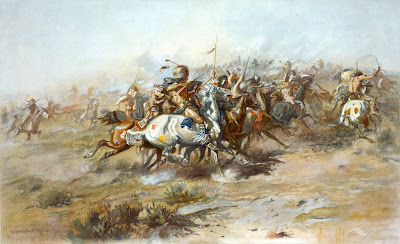 |
| The Custer Fight - Charles Marion Russell |
As facts would have it, the Little Bighorn River is a 138-mile tributary of the Bighorn River proper that runs from Wyoming into Montana. The Bighorn River itself is named for the mountain sheep indigenous to the area. A bit on the nose, it's true, but that branch became famous following the Battle of the Greasy Grass, commonly known by the US Army as Custer's Last Stand. In 1876, Crazy Horse fought alongside a coalition of forces that included the Lakota Sioux, Northern Cheyenne and Arapaho tribes against the 7th Cavalry Regiment under George Custer.
The river's other name, the Greasy Grass, arose from the tall grasses that grew in the riparian zone and held the morning dew. When the horses were ridden through the wet grass, the transference of moisture would cause their bellies and the moccasins of their riders to appear wet and greasy.
https://en.wikipedia.org/wiki/Battle_of_the_Little_Bighorn
https://en.wikipedia.org/wiki/Little_Bighorn_River